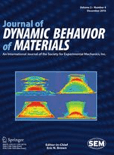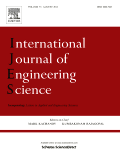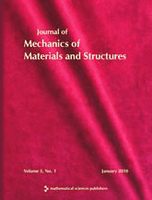
MECHANICS OF TIME-DEPENDENT MATERIALS
metrics 2024
Transforming Knowledge in Mechanical Behavior Under Time Variability
Introduction
MECHANICS OF TIME-DEPENDENT MATERIALS is a prestigious academic journal published by Springer, dedicated to advancing the understanding of the mechanical behavior of materials under time-dependent conditions. With ISSN 1385-2000 and E-ISSN 1573-2738, this journal has been at the forefront of research since its inception in 1997 and aims to publish high-quality contributions that explore fundamental and applied aspects of mechanics in various engineering disciplines. Featured in notable quartiles such as Q2 in Aerospace Engineering and Materials Science, MECHANICS OF TIME-DEPENDENT MATERIALS ranks among the top journals in its field, holding the 36th position in Aerospace Engineering, indicating its significant influence on contemporary research and application. Our goal is to provide a platform that fosters innovation and shares transformative research, catering to a diverse audience of researchers, professionals, and students interested in materials science and engineering. With a commitment to rigorous peer review and high publication standards, the journal plays a vital role in disseminating knowledge that drives advancements in understanding time-dependent viscoelastic and viscoplastic behaviors of materials.
Metrics 2024
 0.62
0.62 2.10
2.10 2.60
2.60 51
51Metrics History
Rank 2024
Scopus
IF (Web Of Science)
JCI (Web Of Science)
Quartile History
Similar Journals

JOURNAL OF SANDWICH STRUCTURES & MATERIALS
Shaping the Future of Mechanical EngineeringJournal of Sandwich Structures & Materials, published by SAGE Publications Ltd, is a premier academic journal dedicated to advancing the study and innovation in sandwich structures and materials. Established in 1999 and running through 2024, this journal has carved out a significant niche in the fields of Ceramics and Composites, Mechanical Engineering, and Mechanics of Materials, earning a notable reputation with its 2023 Q1 rankings in each category. With a commendable Scopus ranking of #53 in Mechanical Engineering and #19 in Ceramics and Composites, it stands out in its commitment to quality research and impactful scholarly contributions. Although there are no Open Access options available, the journal acts as an essential resource for researchers, professionals, and students seeking to explore innovative applications and theoretical advancements in sandwich structures. By providing a platform for high-quality research, it fosters interdisciplinary collaboration and promotes advancements that can inspire future innovations in engineering and materials science.

Rock and Soil Mechanics
Advancing Knowledge in Rock and Soil MechanicsRock and Soil Mechanics is a premier academic journal published by SCIENCE PRESS focusing on the critical fields of civil and structural engineering, geotechnical engineering, and soil science. With an ISSN of 1000-7598 and transitioning to an Open Access format since 2020, the journal strives to enhance the accessibility of cutting-edge research to a global audience, making significant contributions to practices and methodologies in these crucial disciplines. Ranked in the Q2 category for Civil and Structural Engineering as well as Geotechnical Engineering and Engineering Geology, and Soil Science, it boasts respectable standings in Scopus rankings, further affirming its relevance and credibility within the scientific community. The journal not only serves as a platform for original research but also engages with the latest advances in technology and innovative applications in rock and soil mechanics, proving invaluable for researchers, practitioners, and students alike as they navigate an increasingly complex field of study.

Journal of Dynamic Behavior of Materials
Advancing Research in Material MechanicsThe Journal of Dynamic Behavior of Materials, published by SpringerNature, serves as a premier platform for the dissemination of innovative research in the fields of materials science and mechanics of materials. With its ISSN 2199-7446 and E-ISSN 2199-7454, this international journal has established itself since its inception in 2015, showcasing groundbreaking insights into the dynamic properties and behaviors of various materials. Operating from Switzerland and headquartered in London, this journal embraces an open-access philosophy, albeit not entirely, to enhance research visibility. According to the Scopus rankings, it is positioned in the Q3 quartile for both materials science and mechanics of materials, indicating its growing prominence in the academic landscape. Researchers and professionals alike benefit from its wide-ranging contributions that address contemporary challenges and advancements, making it a critical resource for advancing knowledge and innovation in these crucial fields.

INTERNATIONAL APPLIED MECHANICS
Connecting Scholars to the World of Applied MechanicsINTERNATIONAL APPLIED MECHANICS, published by Springer, is a pivotal journal within the realm of Mechanical Engineering and Mechanics of Materials. With an ISSN of 1063-7095 and an E-ISSN of 1573-8582, this journal serves as a vital resource for researchers and professionals seeking to stay at the forefront of applied mechanics from 1992 to 2024. Although currently categorized in Q4, with a Scopus ranking reflecting its evolving impact (479 out of 672 in Mechanical Engineering and 303 out of 398 in Mechanics of Materials), the journal continually strives to publish innovative research that bridges theoretical concepts and practical applications in mechanics. Notably, it does not offer Open Access, allowing for a focused distribution amongst scholars and institutions. The journal's contributions are essential for advancing knowledge, fostering collaboration, and enhancing education in the diverse fields of engineering mechanics.

INTERNATIONAL JOURNAL OF ENGINEERING SCIENCE
Advancing the Frontiers of Engineering KnowledgeInternational Journal of Engineering Science, published by Pergamon-Elsevier Science Ltd in the United Kingdom, stands as a premier platform for pioneering research in the diverse fields of engineering and materials science. Since its inception in 1963, this journal has consistently demonstrated its commitment to advancing academic discourse, maintaining an impressive trajectory that positions it in the Q1 category across multiple engineering disciplines including Mechanical Engineering and Mechanics of Materials as of 2023. With notable Scopus rankings—placing it in the top 5% percentile for Mechanical Engineering and related fields—this journal attracts high-quality, impactful research designed for both industry practitioners and academic scholars. Although it does not currently offer Open Access options, its readership is enriched by comprehensive peer-reviewed articles, fostering a deeper understanding of complex engineering problems and innovative solutions. The International Journal of Engineering Science continues to be an invaluable resource for researchers, professionals, and students committed to pushing the boundaries of knowledge in engineering and materials science.

COMPUTATIONAL MECHANICS
Exploring the Synergy of Mathematics and MechanicsCOMPUTATIONAL MECHANICS, published by SPRINGER, is a premier international journal that focuses on the intersection of applied mathematics, engineering, and computational methods. With a commendable Q1 ranking in multiple categories, including Applied Mathematics and Mechanical Engineering, this journal is pivotal for disseminating groundbreaking research and innovative methodologies that advance the field. The journal has steadily contributed to the academic community since its inception in 1986 and continues to lead discussions and practices in computational mechanics and related disciplines. With a robust impact reflected in its Scopus rankings—placing it within the top percentiles across various categories—COMPUTATIONAL MECHANICS serves as a crucial platform for researchers, professionals, and students seeking to explore and contribute to significant advancements in computational theory and mathematical applications. Although it does not currently operate under an open access model, the journal ensures wide accessibility through libraries and institutional subscriptions, fostering a rich exchange of knowledge in the global scientific community.

Extreme Mechanics Letters
Connecting Scholars with Cutting-Edge DiscoveriesExtreme Mechanics Letters is a distinguished scholarly journal published by Elsevier, focusing on advanced insights in the realms of bioengineering, mechanical engineering, chemical engineering, and mechanics of materials. With an impressive Q1 ranking in multiple categories and a strong representation in Scopus, this journal serves as a vital platform for researchers aiming to disseminate pioneering findings in extreme mechanics. Since its inception in 2014, the journal has rapidly established itself as a leading publication within its field, attracting high-quality manuscripts that push the boundaries of current understanding. As an important resource for professionals and scholars alike, Extreme Mechanics Letters provides valuable insights critical for driving innovation in engineering disciplines. While the journal currently operates on a subscription-based access model, it remains committed to fostering scholarly communication across the globe, ensuring that cutting-edge research reaches its intended audience.

Journal of Mechanics of Materials and Structures
Exploring the Dynamics of Mechanics and Material Integrity.Journal of Mechanics of Materials and Structures, published by Mathematical Science Publishers, is a distinguished periodical in the field of Applied Mathematics and Mechanics of Materials. With the ISSN 1559-3959, this journal has been a pivotal platform since its inception in 2006, providing insights and advancements in the mechanics of materials and their structural applications. Operating out of the University of California, Berkeley, this journal not only boasts a respectable standing within its categories, ranking Q4 in Applied Mathematics and Q3 in Mechanics of Materials as of 2023, but it also serves a crucial role in fostering academic discourse among researchers, practitioners, and students alike. Although it does not currently offer open access, its contributions to the respective fields are invaluable, underscoring the relevance and importance of continued research in understanding material behavior and structural integrity. Whether investigating theoretical frameworks or engineering applications, the Journal of Mechanics of Materials and Structures remains an essential resource for anyone dedicated to the advancement of the science of materials and structures.

JOURNAL OF ELASTICITY
Innovating Understanding in Elasticity and BeyondJOURNAL OF ELASTICITY is a prestigious peer-reviewed journal dedicated to the study and advancement of the field of elasticity and its numerous applications across various disciplines. Published by SPRINGER, and located in the Netherlands, this journal has been a key resource since its inception in 1971, providing critical insights and developments up through 2024. With a commendable impact factor and categorized within the Q2 quartile in areas such as Materials Science, Mechanical Engineering, and Mechanics of Materials, the journal maintains a significant standing in the academic community. Researchers and professionals will find a wealth of knowledge through advanced theoretical and experimental studies published within its pages, contributing to both foundational understanding and practical applications. While currently not an open access publication, the JOURNAL OF ELASTICITY remains an essential platform for innovative research and discussions that shape the future of mechanical sciences.

Materials Physics and Mechanics
Exploring the Mechanics of Tomorrow's MaterialsMaterials Physics and Mechanics is a pivotal journal dedicated to advancing the fields of condensed matter physics, materials science, mechanical engineering, and the mechanics of materials. Published by the Institute of Problems in Mechanical Engineering, Russian Academy of Sciences, this journal has established itself as a valuable resource since its inception, particularly from 2003 to 2004 and now continuously from 2009 to 2024. Although it currently holds a Q4 categorization in various disciplines, its contributions are critical to understanding and developing new materials and their applications in engineering. The journal provides insightful articles that explore the nuances of material properties, their behaviors under different conditions, and the physical principles governing these phenomena. Though it operates under a traditional publication model, the insights provided within its pages are invaluable to researchers, professionals, and students striving to push the boundaries of knowledge in the materials domain. Its ISSN numbers (1605-2730, E-ISSN 1605-8119) serve as a gateway to a wealth of scientific knowledge emanating from the Russian Federation, contributing to the global discourse in materials physics and mechanics.